Greetings. My name is Chie Sunohara from Dentsu’s Food & Life Lab. In this article, we will focus on the food habits of Japan’s young generation, teenagers in particular.
In five or 10 years from now, these young people will have their own families within society and will have a major influence on our food culture.
By understanding the characteristics and social background behind teenagers’ values and behavior around food, we’ll be able to identify key challenges specific to Japanese food culture and perhaps its future as well.
To understand the future of our food culture as envisaged by consumers, Dentsu conducted a survey to assess people’s food-related expectations for the foreseeable future.
In the survey, we presented 40 topics related to food & eating habits and then asked the respondents, in the next three to four years, if they think: first whether each topic would increase or decrease and second whether each respondent would want more or less of each topic. The results were converted to scores and the mean scores for each item were plotted to produce charts predicting trends over the foreseeable future.
Chart 1
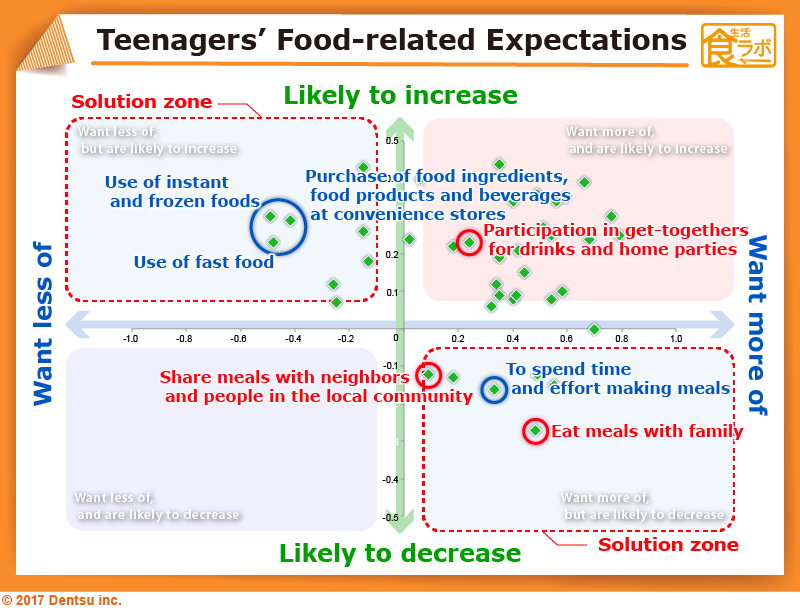
In the upper left-hand quadrant of the above chart, topics that consumers “want less of, but are likely to increase” are placed.
In the lower right-hand quadrant, topics that consumers “want more of, but are likely to decrease” are placed.
The items that fall within these two quadrants reveal a gap between consumer ideals and reality. Hence the quadrants that are labeled “solution zones” require convergence.
From the results garnered from teenagers, we were able to identify a clear desire to “eat decent meals” and to do so “together with others.” This is related to the social media culture that has become a part of teenagers’ everyday lives, as I will explain in the section below on food and Instagram.
Teenagers’ Meals: desire for decency rather than speed
Chart 2
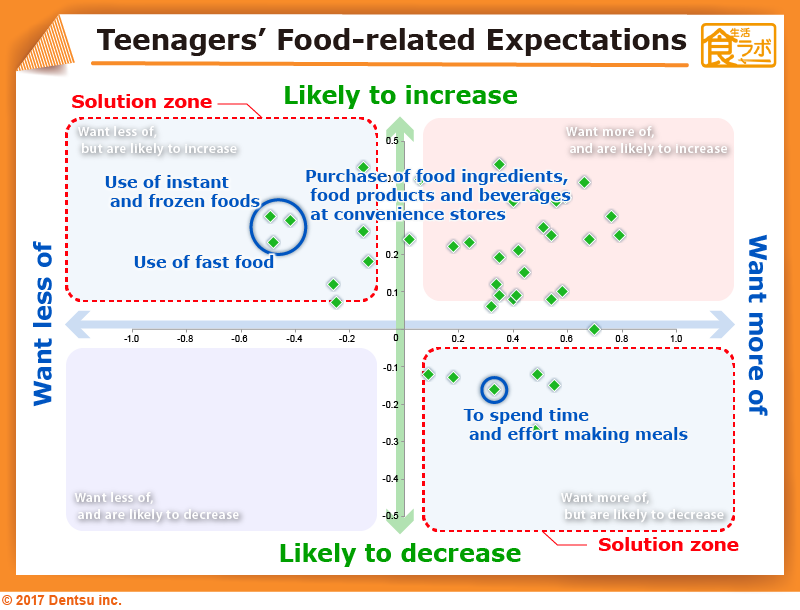
Chart 3
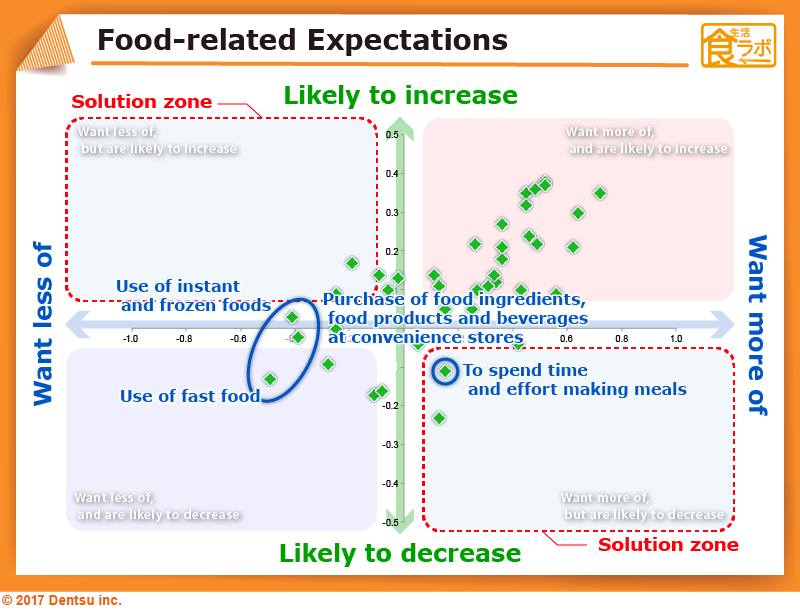
In charts 2 and 3 we compared the foreseeable future prediction chart for teenagers with that of all other age groups.
From the distribution of 40 topics indicated by teenagers, we see two things: first that a larger number of items fall within the solution zones than is the case for other age groups; and, second, that the positions of these items reveal particularly high scores.
This indicates that teenagers have a high level of consciousness toward their food & eating habits.
When we look at the topics within the solution zones, in the upper left-hand quadrant that consumers “want less of, but are likely to increase,” we see usage of “instant and frozen foods,” “convenience store foods,” and “fast food.”
In the lower right-hand quadrant that consumers “want more of, but are likely to decrease,” we see the topic of “to spend time and effort making meals”.
We can clearly see that Japanese teenagers do have a sincere attitude toward their food & eating habits.
Next, we compared the attitudes of males and females among the teenagers.
Chart 4
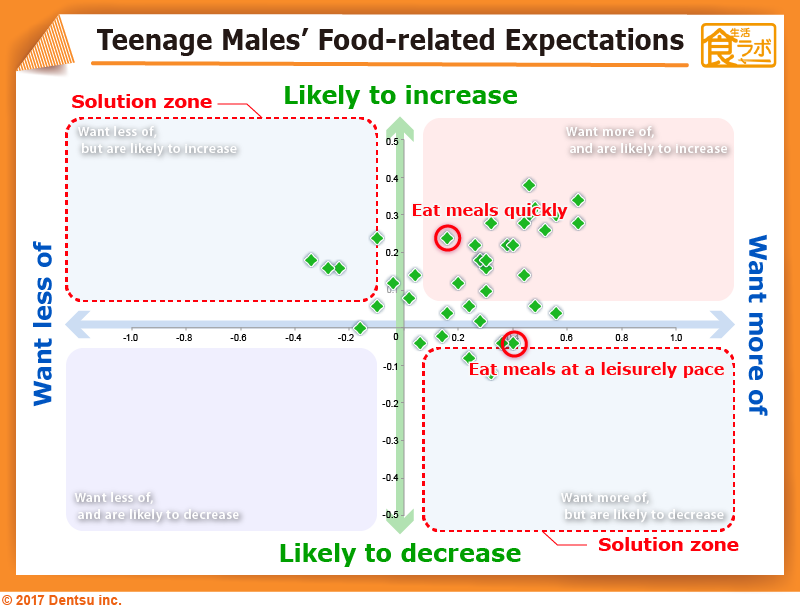
Chart 5
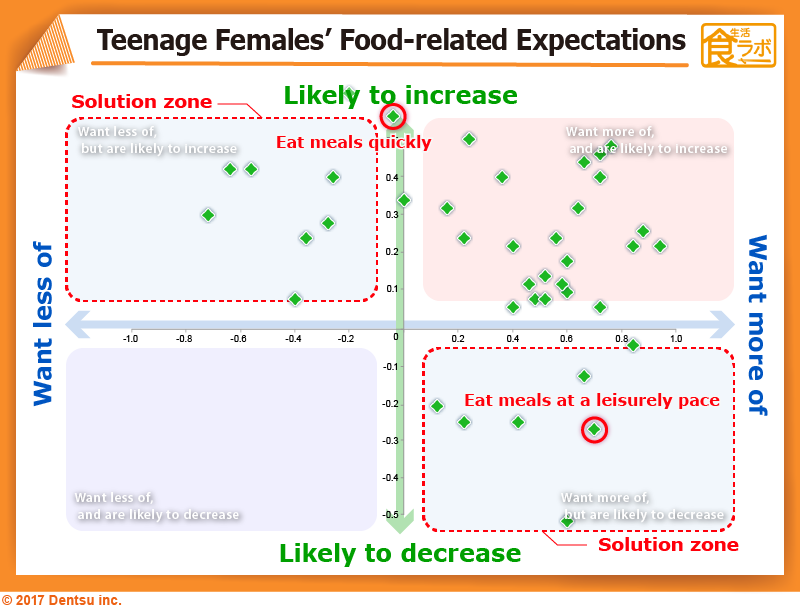
The scores plotted in solution zones were higher for teenage females than for teenage males. This shows that females exhibit a stronger desire to avoid convenient and simple foods, preferring to consume more foods that require time and effort to prepare.
The differences between males and females were even more pronounced regarding the time spent on meals.
In the case of teenage males, the item “eat meals at a leisurely pace” was plotted near the center of the solution zone, and “eat meals quickly” did not fall within the solution zone.
However, for teenage females, both “eat meals at a leisurely pace” and “eat meals quickly” had high solution zone scores.
These results indicate that teenagers, particularly females, do not see eating simply as nutrition but rather hope to be actively involved in food and eating by spending time and effort. This, however, is not something easy to accomplish based on their perception.
Food: delicious when eaten with others
chart 6
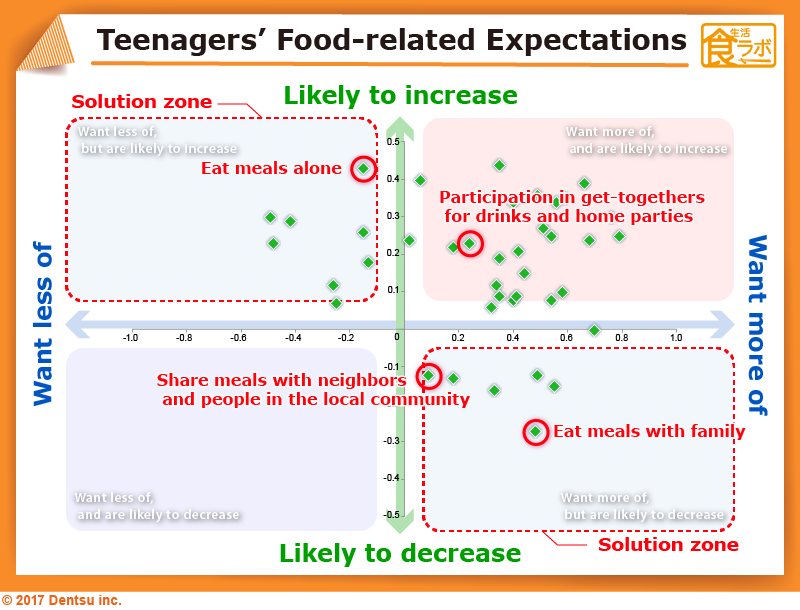
Also interesting to note is the high scores of “eat meals alone” in the “want less of, but are likely to increase” quadrant, and “eat meals with family” in the “want to more of, but are likely to decrease” quadrant.
Although teenagers place greater importance than other age groups on “eat meals with family,” their daily routines make achieving this goal difficult. This is understandable, given that children nowadays tend to have busy schedules that include coaching in school subjects, as well as extracurricular lessons and activities.
In addition, one should note that, these days, the parents of teenagers tend to be in their late thirties and forties and in the prime of their working lives. This means they spend limited time at home.
Recently in Japan, “Ichijyu Issai (a simple meal literally meaning one soup and one dish)” and “Tsukuoki (precooked dishes)” have become quite popular. The survey results suggest that a reduction in the time spent on meal preparation is helping parents cope better and is a good solution for children.
The survey also indicates that teenagers wish to increase face-to-face interaction with other people, in such situations as “get-togethers for drinks and home parties” and “meals with neighbors and people in the community.”
Since this characteristic was only seen among teenagers, one can surmise that teenagers have a strong desire to enjoy food in the company of others.
Food: most Instagrammable item
Any discussion of the habits of teenagers would not be complete without the inclusion of comments on the use of Instagram and other social media.
When we think of the Instagrammable phenomenon, a typical scene that comes to mind is a group of teenage women taking a selfie with photogenic desserts in front of them, as they try to get the perfect shot.
Why does food tend to be at the center of so many Instagram posts? One reason may be the position of food as a type of content, which combines the traits of universality and individuality.
Since almost everybody eats three times a day, food has universality in its nature as content for everyone, making it easy both to post photographs of food on social media, and for viewers to click “Like.”
A person can communicate their lifestyle and personal values in an easily understandable way. Through such scenes as a colorful parfait one can express interest in things that are cute and pretty; through a home-cooked meal, meanwhile, one can show the results of one’s efforts and capture an important aspect of one’s home life.
A way of expressing that one’s company is desired by one’s peers may include a photo with one’s boyfriend at a caf? on a weekend, or a photo of a club barbecue.
Most important, all the above instances enable people to show off their individuality.
Teenagers want to reinforce their self-image so that others will see them in a positive light and recognize their desirable traits. They thus depict themselves as eating proper meals or food they like, together with friends or family. This paints them as not merely satisfying their hunger with instant food or food bought at convenience stores, and eating it alone.
As a result, teenagers’ relationship with food may be thought of as embodying that which is Instagrammable.
Since food is intimately related to lifestyle, it is an accurate sign of the times. Thus, after the Second World War, eating came to be associated with extravagance. Later, we saw the popularization of instant foods, in an era of rapid economic growth; people felt they must sacrifice some of the time spent on preparing and eating meals and devote this to work.
During the late 1980s in the bubble economy era, food was used as a status symbol and people were seen competing on the basis of luxury. Meanwhile, in the years of economic stagnation that followed, cost performance was emphasized and people turned to familiar ingredients and healthy diets.
These days, with many teenagers and other young people seeing food as a type of media content, they may well be curating themselves through social media.
In recent years, drinks and other products have been developed that purport to provide completely balanced nutrition in a single cup. Such developments are making it less necessary to allocate time and effort to meals.
Despite this, meals have once again been transformed and play a central role in communication among teenagers. Mealtimes continue to be loved as an important part of their lives.
As long as teenagers continue to take an interest in food, we at Food & Life Lab at Dentsu believe that the future of Japanese food culture remains bright.
Note
The Internet survey on foreseeable future on food & eating habits was conducted in September 2016, nationwide across Japan, to 1,200 males and females between 15 and 79 years of age. 40 food-related topics were presented to the respondents.
